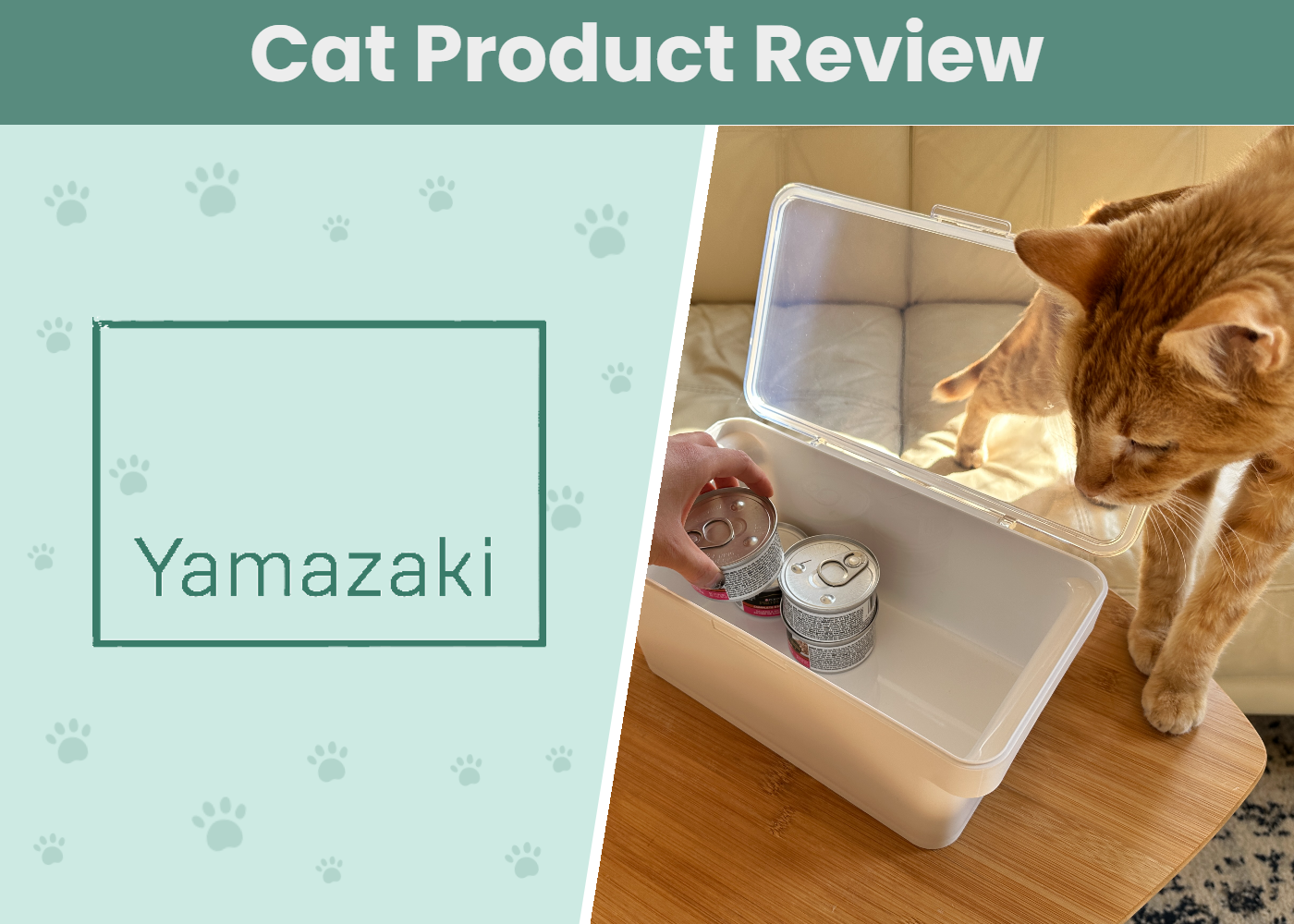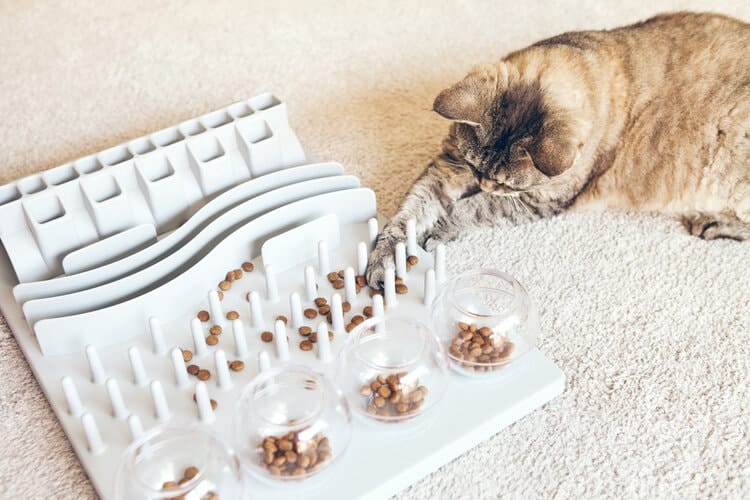
There are many interesting slow-feed cat bowls available nowadays, but they are not all created equally. The process of comparing options can be confusing, especially if you do not know what kinds of features, designs, and functions to look for. We are here to make the process of finding the perfect slow-feed cat bowl for your feline family member easy by breaking down the 10 best options on the market this year. Here are reviews for our favorites and a list of pros and cons to consider for each.
A Quick Look at Our Winners of 2024
| Image | Product | Details | ||
|---|---|---|---|---|
| Premium Choice |
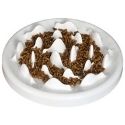
|
Lorde Slow Feeder Cat Bowls |
|
CHECK PRICE |
| Best Overall |
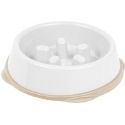
|
IRIS Slow Feeding Cat Bowl |
|
CHECK PRICE |
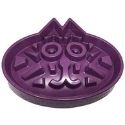
|
Simply Pets Online Slow Feed Cat Bowl |
|
CHECK PRICE | |
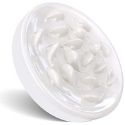
|
GooFoto Slow Feeder Food Bowl |
|
CHECK PRICE | |

|
Catit Senses 2.0 Digger Interactive Feeding Toy |
|
CHECK PRICE |
The 10 Best Slow Feed Cat Bowls
1. Lorde Slow Feeder Cat Bowls – Best Overall
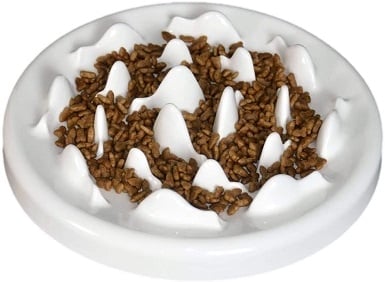
This slow feed bowl is cute, effective, and easy to take care of. It has a fish-shaped maze design that acts as an obstacle that your cat must overcome to get to their food. The bowl is made of non-toxic ceramic materials and can be thrown in the dishwasher for easy cleaning between meals. It’s also microwave-safe, so you can warm wet food up a little before serving your cat a meal on a cold day.
The surface is nice and smooth, so you do not have to worry about your kitty injuring their mouth while trying to get to their food. The fish maze ridges are not too tall, so your cat will not struggle to get nutrition, but they are just high enough that they will need to work a little for each bite, giving them the satisfaction of “catching” their food. The Lorde slow feeder cat bowl is skid-proof, so it will stay in place while your kitty works for their food.
To conclude, we think this is the best overall slow feeder for cats available this year.
- Features a cute fish-shaped maze design
- Made of non-toxic materials
- The non-skid bottom keeps the bowl in place
- Food tends to spill off the sides of the bowl, which can make a mess
2. IRIS Slow Feeding Cat Bowl – Best Value
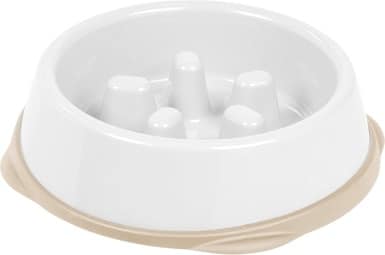
This is a deep-set slow-feeding bowl that is suitable for both cats and small dogs. It’s made of plastic that does not stain and is BPA-free. This is the best slow-feed cat bowl for the money because it’s priced right and does not disappoint when it comes to performance. The IRIS slow feeding bowl comes in two different sizes and a few different colors, allowing you to choose one that fits your cat’s unique personality.
The rubber base helps hold the bowl in place so it does not tip over or slide around while it’s being eaten out of. The bowl can hold up to 16 ounces of dry or wet food at one time, which should be more than enough to fill up your kitty in one sitting. If your cat likes to bite and chew on things, this bowl can end up with chew marks around the edges, which can make it harder to clean.
If you’re looking for the best bang for your buck, we think this slow feed cat bowl is a good option.
- Features a rubber base to keep the bowl in place
- Comes in two sizes and multiple colors
- Holds up to 16 ounces of food at a time
- Cats may create marks on the bowl by chewing on it
3. Simply Pets Online Slow Feed Cat Bowl
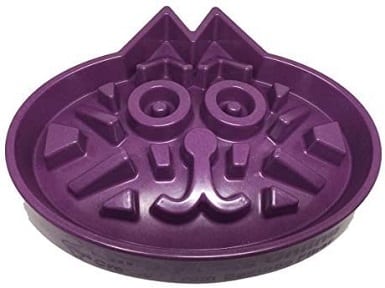
The Simply Pets Online slow feed cat bowl was designed by a couple of veterinarians who needed something reliable to utilize in their clinic. Made of bamboo fiber, this is an eco-friendly bowl that contains absolutely no toxins, chemicals, plastics, or PVC. The large base is shaped and designed like a cat’s head and offers plenty of room for food dispersal so your cat can enjoy the challenge of foraging for every bite.
The food reservoirs are wide enough for cats to use their paws for foraging, offering them multiple interactive ways to eat. The bowl comes with complete instructions that will show you how to get your cat started with minimal frustration. The bowl does not have a skid-free bottom, but the base is so large that it tends to stay in place when a cat interacts with it.
- The large base encourages foraging
- Made of natural bamboo for a low carbon footprint
- Food reservoirs are wide enough for kitty paws
- The bowl is much larger than an average-sized cat food dish
4. GooFoto Slow Feeder Food Bowl
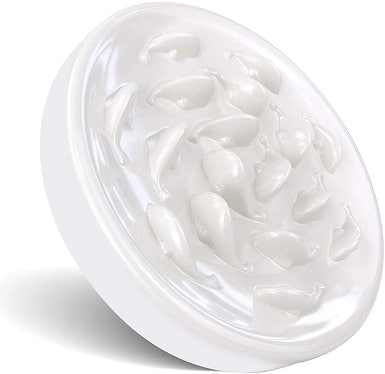
This slow-feeder food bowl was designed with health and wellness in mind. It has a swirl pattern design that encourages the use of legs and paws, helping to keep your kitty agile and in good shape, which is especially helpful if they aren’t that active throughout the day. Made of 100% melamine, the GooFoto slow feed bowl is non-toxic and free of lead and cadmium. It is also dishwasher safe.
The bowl has rounded corners, so nobody will stub their toe and injure themselves if they trip on it, and your cat will be less likely to hurt themselves while eating. We especially like how easy it is to pick the bowl up when it is time to clean it. However, the grip strips on the bottom of the bowl are not that effective.
- Promotes agility and physical fitness
- Made of 100% melamine
- Rounded corners minimize the risk of injury
- The bowl feels flimsy
- Grips are not that effective
5. Catit Senses 2.0 Digger Interactive Feeding Toy
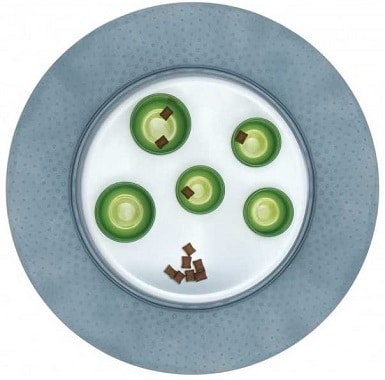
This unique slow-feed bowl is more for snack time than for meals, but it serves the same purpose of helping kitties slow down while eating and providing them with challenges and interactions. The base holds five included tubes — three short and thin ones and two tall and wide ones — that can be filled with dry treats. The idea is for your cat to use their paws and scoop the treats out.
The tubes do not all have to be inserted at the same time and can be moved around to create different challenges. A large non-skid mat is included, which the base of the slow feed bowl should sit on. Without the mat in place, this bowl will move around quite a bit while being used. The plastic material that this system is made of is BPA-free to ensure a clean and safe experience during snack time.
- Unique design made for optimal interaction
- Easy to hand-wash
- Various challenge puzzle options are available
- Requires hand assembly before each use
6. Catit Senses 2.0 Cat Food Tree
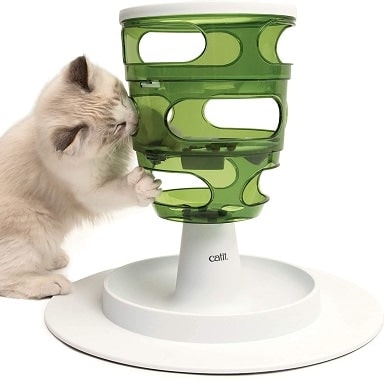
This food tree offers a jungle gym experience that will keep your cat active while they enjoy their meal. Featuring three different difficulty levels, your cat will never get bored when it is time to eat. The product is made of BPA-free plastic and is easy to handwash, but it should not be put in the dishwasher because it cannot withstand the heat.
Dry food can be placed inside any one of the multiple tires, and then your cat will work to get the food out of the contraption through various holes on the sides. Any food that falls out will be caught by the base tray, where your cat can easily nibble them up so there is never any waste. Just beware that your kitty is bound to improve their dexterity skills while eating their meals when using the Catit Senses 2.0 cat food tree.
- Offers a fun jungle gym experience
- Features three different difficulty levels
- BPA free
- Not dishwasher safe
7. Neater Pet Brands Slow Feeder Cat Bowl
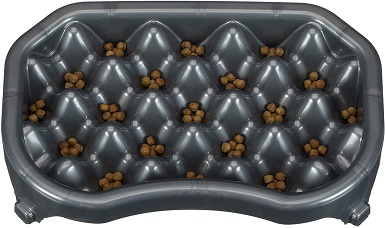
The Neater Pet Brands slow feeder cat bowl is dual-purpose. The base acts as a water or regular food dish, and the top liner performs as a slow feeder. The liner has shallow lumps that separate your cat’s dry food into small sections that must be reached via paws or licking. This non-toxic and non-slip bowl is made in the United States and can accommodate cats and dogs of all breeds.
The feeder holds up to 2.5 cups of dry food at a time, but it is not designed to accommodate wet food. The bowl is long and narrow, so two cats can forage for food at the same time. Both snacks and meals can be offered using this slow-feeder cat bowl. On the downside, the design and shape of this slow feeder are lacking compared to others on this review list.
- Can be used for both food and water
- Can hold up to 2.5 cups of dry food at one time
- Accommodates both snacks and meals
- The design lacks some of the interactive features of others on this review list
8. NOYAL Cat Slow Feeder Bowl
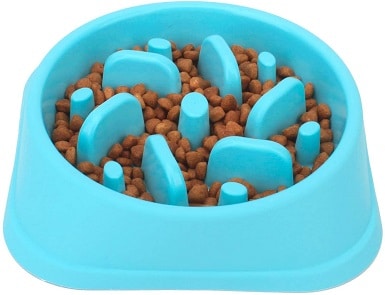
A swirl flower maze design is what sets this slow-feed cat bowl apart from the others. The swirly pattern makes cats think twice before trying to devour their food. They will have to work for each bite as they use their nose, mouth, and paws to get every morsel. The bowl holds about 1.5 cups of food and is suitable for both shy and vigorous eaters.
The bright colors available for this bowl make it a fun go-to snack and meal dispenser that both humans and cats can appreciate. The base is somewhat skid-proof but will not prevent the bowl from sliding around on a tile or wooden floor. Overall, the bowl is fun, durable, and interesting, which makes it a good daily toy for your cat to interact with.
- Features a cute flower maze design
- Available in fun colors
- Holds 1.5 cups of food at one time
- Not that skid-proof
- Lighter and less durable than other options on this review list
9. Super Design Anti-Gulping Cat Bowl Slow Feeder

Designed for both dogs and cats, this is a basic slow feeder bowl that has the same shape as a regular feeding dish. Inside the dish are three ridges that act as obstacles to help slow the eating process down. The bowl is made of melamine, which is free of toxic additives and chemicals that could harm your cat’s health as time goes on. The heavier material makes the bowl harder to move around while being eaten out of.
Both dry and wet food can be used with this product, although wet food tends to dry up quickly, so washing should be a priority soon after feeding time. Convenient indents on the bottom of the bowl make it easy to pick up off the floor. The skid resistance is minimal, and the bowl size is small, so this may not be the right model for your cat if they are a large breed that likes to eat.
- Suitable for both dogs and cats
- Made of non-toxic materials
- Small bowl size may not accommodate large cat breeds
- Not that skid-resistant
10. URWOOW Collapsible Slow Feeder Cat Bowl
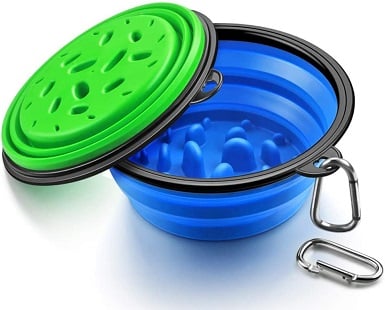
This is the perfect traveling slow feed cat bowl because it comes with a leak-proof top and can be compacted into a flat shape that is easy to stow away, whether in a large suitcase or a small backpack. You can pack the bowl full of food and put on the lid so meals are ready while on the road, or collapse the bowl and fill it up wherever you end up while on vacation or when traveling to a new home.
This collapsible bowl is made of silicone that is free of BPA toxins, and while it collapses on demand, it is sturdy while assembled and will not collapse while your feline family member is eating. This is not a great option for everyday home use, however, and the collapsible ridges can make it tough to get completely clean when wet food is offered at mealtime.
- Collapsible design makes traveling easy
- Free of BPA and other toxins
- Not suitable for daily use at home
- Can be tough to get wet food out of the crevices
- You might also be interested in: 8 Best Luxury & Modern Cat Bowls – Reviews & Top Picks

Buyer’s Guide: Selecting the Best Slow Feed Cat Bowl
Because there are so many great slow-feed cat bowls available on the market, it can become confusing when trying to narrow the options down. This buyer’s guide should help you find the perfect product for the needs of you and your feline family member. Here are a few tips, tricks, and insights to consider.
Know Your Cat’s Needs
It is important to understand your cat’s specific needs before choosing a new slow-feed bowl for them to utilize at mealtime. Do they eat too quickly and develop indigestion after meals, or do they need more stimulation and exercise? A basic setup is ideal for simply getting a cat to eat slower. A more interactive puzzle design is ideal for cats that need more exercise or practice with paw skills.
Young kittens and older cats should start with a basic maze design, while cats in their prime and those that are advanced when it comes to dexterity and problem-solving skills should have a more complex setup. If you are unsure of what types of slow feeders your cat will respond the best to, start with a basic one, and once it has been mastered, consider buying a more advanced puzzle feeding system.
Understand Your Preferred Setup
It is also a good idea to make sure that you know what your preferred setup is before starting your search for a new slow-feed cat bowl. Will you be feeding your cat on a slick floor, like tile, or something like carpet or a throw rug? Slick floors typically require skid-proof slow-feeder cat bowls to stay in place, but you do not have to worry about this issue if the bowl is going to be on a rug.
If you plan to feed your cat on an elevated table, shelf, or counter, make sure that the bowl can be screwed down or that it at least comes with a rubber mat that will keep it from being shoved over, which can lead to huge messes on the floor. Choose a specific spot in the house to set up the slow feeder so you know what kind of stability you should be looking for.
Choosing the right food and water bowls for our feline companions can pose certain challenges for pet owners. The Hepper NomNom Cat Bowl provides a chic and innovative solution that supports cat specific needs, such as shallow bowls and a subtle elevation that fosters whisker relief, posture comfort, and improves digestion. It features an elegant contemporary design with a wide wrap-around tray aimed at minimizing any messes from ending up on your floor! Furthermore, this bowl is entirely dishwasher safe, so pet owners are able to spend more time with their cats instead of cleaning up after them. Discover why the Hepper NomNom Cat Bowl is right for both you and your kitty by clicking here. At Catster, we’ve admired Hepper for many years and decided to take a controlling ownership interest so that we could benefit from the outstanding designs of this cool cat company!
Talk to Your Veterinarian
It never hurts to consult with your veterinarian before buying your cat a new slow-feed bowl. They can provide you with custom guidance and recommendations based on things like your cat’s age, medical history, and current health status. They can let you know what kinds of materials to stay away from and which to look for. They can also recommend how challenging the feeding bowl should be and how much food the bowl should hold at any given time. You can provide them with information about any slow-feeding bowls that you might be interested in to get expert feedback.
Conclusion
Hopefully, these slow-feeder cat bowl reviews can help you more easily decide which will work best for your furry feline friend. We love the first option on our list, the Lorde slow feeder cat bowl, because it is made of high-quality materials and has a cute fish-shaped ridge design. Our second choice, the IRIS slow feeding bowl, offers the best bang for your buck because it comes in multiple sizes and colors and can hold up to 16 ounces of food at a time.
With so many designs and features available, you should not have a problem finding something that your cat can thoroughly enjoy and benefit from. Are any specific options on our reviews list that are appealing to you? If so, why? Let us know your thoughts by leaving a message in our comments section.
Featured Image Credit Veera, Shutterstock
Contents
- A Quick Look at Our Winners of 2024
- The 10 Best Slow Feed Cat Bowls
- 1. Lorde Slow Feeder Cat Bowls – Best Overall
- 2. IRIS Slow Feeding Cat Bowl – Best Value
- 3. Simply Pets Online Slow Feed Cat Bowl
- 4. GooFoto Slow Feeder Food Bowl
- 5. Catit Senses 2.0 Digger Interactive Feeding Toy
- 6. Catit Senses 2.0 Cat Food Tree
- 7. Neater Pet Brands Slow Feeder Cat Bowl
- 8. NOYAL Cat Slow Feeder Bowl
- 9. Super Design Anti-Gulping Cat Bowl Slow Feeder
- 10. URWOOW Collapsible Slow Feeder Cat Bowl
- Buyer’s Guide: Selecting the Best Slow Feed Cat Bowl
- Conclusion







